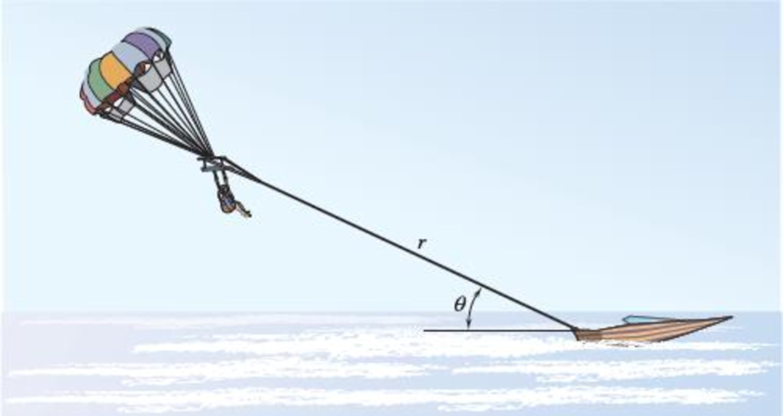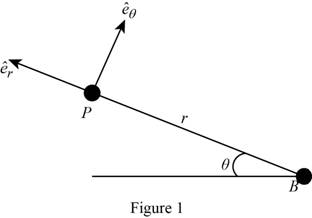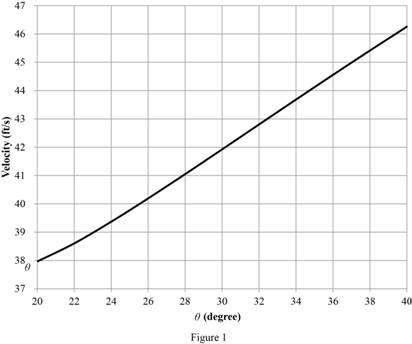
Concept explainers
Some parasailing systems use a winch to pull the rider back to the boat. During the interval when θ is between 20° and 40° (where t = 0 at θ = 20°), the angle increases at the constant rate of 2°/s. During this time, the length of the rope is defined by the relationship
Fig. P11.163 and P11.164

(a)
Plot the magnitude of the velocity of the parasailer as a function of time.
Explanation of Solution
Given Information:
During the interval the
The angle
The length of the rope is define by the relationship (r) of
The boat is travelling at a constant velocity
Calculation:
Convert the knot to feet per second.
Consider
Show the Free body diagram of parasailer and boat as in Figure (1).

Write the velocity
The acceleration vector of the boat is as follows:
Differentiate angle
Differentiate radius (r) with respective to time (t).
Differentiate
Write the expression for velocity vector
Here,
Write the expression for acceleration vector
Here,
Write the velocity vector
Write the acceleration vector
Write the velocity vector
Substitute
Calculate velocity vector of parasailer at an angle
Substitute 0 for t,
Here,
Calculate the velocity
Substitute
The time (t) is increase with 1 sec for an angle of
Similarly, calculate the velocity
Summarize the calculated values of velocity as in Table (1).
|
Time(t) (sec) | Radius (r) | |||||
| 0 | 20 | 600.000 | 0.000 | 32.463 | 19.681 | 37.963 |
| 1 | 22 | 599.875 | -0.313 | 33.434 | 19.298 | 38.603 |
| 2 | 24 | 599.293 | -0.884 | 34.616 | 18.751 | 39.369 |
| 3 | 26 | 598.051 | -1.624 | 35.911 | 18.051 | 40.193 |
| 4 | 28 | 596.000 | -2.500 | 37.274 | 17.195 | 41.050 |
| 5 | 30 | 593.012 | -3.494 | 38.676 | 16.180 | 41.924 |
| 6 | 32 | 588.977 | -4.593 | 40.090 | 15.001 | 42.804 |
| 7 | 34 | 583.795 | -5.788 | 41.494 | 13.658 | 43.684 |
| 8 | 36 | 577.373 | -7.071 | 42.867 | 12.149 | 44.555 |
| 9 | 38 | 569.625 | -8.438 | 44.190 | 10.474 | 45.415 |
| 10 | 40 | 560.472 | -9.882 | 45.446 | 8.635 | 46.259 |
Plot the magnitude of the velocity of the parasailer as a function of time as in Figure (1).

(a)
The magnitude of the acceleration
Answer to Problem 11.164P
The magnitude of the acceleration
Explanation of Solution
Given Information:
During the interval the
The angle
The length of the rope is define by the relationship (r) of
The boat is travelling at a constant velocity
Calculation:
Write the expression for acceleration vector
Substitute
Calculate the acceleration vector
Substitute 5 sec for t,
Here,
Calculate the acceleration
Substitute
Therefore, the magnitude of the acceleration
Want to see more full solutions like this?
Chapter 11 Solutions
VEC MECH 180-DAT EBOOK ACCESS(STAT+DYNA)
- Solve for the reaction of all the forces Don't use artificial intelligence or screen shot it, only expert should solvearrow_forwardNo chatgpt plsarrow_forwardA six cylinder petrol engine has a compression ratio of 5:1. The clearance volume of each cylinder is 110CC. It operates on the four-stroke constant volume cycle and the indicated efficiency ratio referred to air standard efficiency is 0.56. At the speed of 2400 rpm. 44000KJ/kg. Determine the consumes 10kg of fuel per hour. The calorific value of fuel average indicated mean effective pressure.arrow_forward
- The members of a truss are connected to the gusset plate as shown in (Figure 1). The forces are concurrent at point O. Take = 90° and T₁ = 7.5 kN. Part A Determine the magnitude of F for equilibrium. Express your answer to three significant figures and include the appropriate units. F= 7.03 Submit ? kN Previous Answers Request Answer × Incorrect; Try Again; 21 attempts remaining ▾ Part B Determine the magnitude of T2 for equilibrium. Express your answer to three significant figures and include the appropriate units. Figure T₂ = 7.03 C T2 |? KN Submit Previous Answers Request Answer × Incorrect; Try Again; 23 attempts remaining Provide Feedbackarrow_forwardConsider the following acid-base reaction: Fe3+(aq) +3H2O -Fe(OH)3 (s) + 3H* ← A. Using thermodynamics, calculate the equilibrium constant K at 25°C (The AG° of formation of Fe(OH)3(s) is -699 kJ/mol). B. Using the value of K you calculated in part a, if a solution contains 10-4 M Fe3+ and has a pH of 7.5, will Fe(OH)3(s) precipitate? Show all calculations necessary to justify your answer. Note that the reaction as written is for precipitation, not dissolution like Ksp-arrow_forwardA vertical force of F = 3.4 kN is applied to the hook at A as shown in. Set d = 1 m. Part A 3 m 3m 0.75 m 1.5 m. Determine the tension in cable AB for equilibrium. Express your answer to three significant figures and include the appropriate units. FAB= Value Submit Request Answer Part B Units ? Determine the tension in cable AC for equilibrium. Express your answer to three significant figures and include the appropriate units. FAC = Value Submit Request Answer Part C ? Units Determine the tension in cable AD for equilibrium. Express your answer to three significant figures and include the appropriate units.arrow_forward
- Consider the heat engine operating at steady state between the two thermal reservoirs shown at the right while producing a net power output of 700 kW. If 1000 kW of heat (Q̇H) is transferred to the heat engine from a thermal reservoir at a temperature of TH = 900 K, and heat is rejected to a thermal reservoir at a temperature of TL = 300 K, is this heat engine possible? Can you answer this question for me and show all of the workarrow_forward1.12 A disk of constant radius r is attached to a telescoping rod that is extending at a constant rate as shown in Fig. P1.12. Both the disk and the rod are rotating at a constant rate. Find the inertial velocity and acceleration of point P at the rim of the disk. ท2 L 0 SS P α e 0 O' êL Fig. P1.12 Rotating disk attached to telescoping rod. 60 LLarrow_forwardTwo different options A and B with brake pads for disc brakes are connected to the rope drum. The diameter of the rope drum is 150 mm. What distance must the pads B be at from the center of rotation to cover the same distance as A?A B- Width 50 mm - Width 60 mm- Evidence center 120mm - Construction power 900 N from rotation center.- Maintains a weight of 200 kgwhen the installation force is 1.4kN (μ is missing from the data)M=μF(Ry-Ri)Right answer R=187 mmarrow_forward
- Assume the xy plane is level ground, and that the vertical pole shown in the diagram lies along the z-axis with its base at the origin. If the pole is 5 m tall, and a rope is used to pull on the top of the pole with a force of 400 N as shown, determine the magnitudes of the parallel and perpendicular components of the force vector with respect to the axis of the post i.e. with respect to the z-axis.arrow_forward4-1 Q4: Q5: (20 Marks) Find √48 using False Position Method with three iterations. Hint: the root lies between 3 and 4. (20 Marks)arrow_forwardDetermine the angle between vectors FA and FB that is less than 180 degrees. FA is the vector drawn from the origin to point A (-4, 4, 2) while FB is the vector drawn from the origin to point B (3, 1, -3).arrow_forward
 Elements Of ElectromagneticsMechanical EngineeringISBN:9780190698614Author:Sadiku, Matthew N. O.Publisher:Oxford University Press
Elements Of ElectromagneticsMechanical EngineeringISBN:9780190698614Author:Sadiku, Matthew N. O.Publisher:Oxford University Press Mechanics of Materials (10th Edition)Mechanical EngineeringISBN:9780134319650Author:Russell C. HibbelerPublisher:PEARSON
Mechanics of Materials (10th Edition)Mechanical EngineeringISBN:9780134319650Author:Russell C. HibbelerPublisher:PEARSON Thermodynamics: An Engineering ApproachMechanical EngineeringISBN:9781259822674Author:Yunus A. Cengel Dr., Michael A. BolesPublisher:McGraw-Hill Education
Thermodynamics: An Engineering ApproachMechanical EngineeringISBN:9781259822674Author:Yunus A. Cengel Dr., Michael A. BolesPublisher:McGraw-Hill Education Control Systems EngineeringMechanical EngineeringISBN:9781118170519Author:Norman S. NisePublisher:WILEY
Control Systems EngineeringMechanical EngineeringISBN:9781118170519Author:Norman S. NisePublisher:WILEY Mechanics of Materials (MindTap Course List)Mechanical EngineeringISBN:9781337093347Author:Barry J. Goodno, James M. GerePublisher:Cengage Learning
Mechanics of Materials (MindTap Course List)Mechanical EngineeringISBN:9781337093347Author:Barry J. Goodno, James M. GerePublisher:Cengage Learning Engineering Mechanics: StaticsMechanical EngineeringISBN:9781118807330Author:James L. Meriam, L. G. Kraige, J. N. BoltonPublisher:WILEY
Engineering Mechanics: StaticsMechanical EngineeringISBN:9781118807330Author:James L. Meriam, L. G. Kraige, J. N. BoltonPublisher:WILEY





